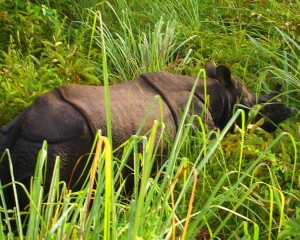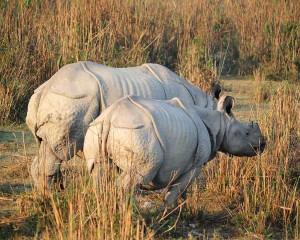
Jaldapara National Park forest is mainly savannah covered with tall elephant grasses. The main attraction of the park is the Indian one horned rhinos.
The park holds the largest rhino population in India after Kaziranga National Park in Assam.
Other animals in the park include leopard, elephants, sambar, barking deer, spotted deer, hog deer, wild pigs, and bison.
Table of Contents
Today, it has the largest population of the Indian one horned rhinos in the state, an animal threatened with extinction.
Some rare species like the hispid hare and the hog-badger are also found here. Besides wildlife viewing, there is scope for unusual holiday activities like elephant riding and leisurely strolls through the towering grass.
Habitat and Distribution:
-
Lush Grasslands and Wetlands:
- Indian one-horned rhinos primarily inhabit the grasslands, marshes, and riverine forests of Jaldapara National Park.
- These habitats provide abundant grazing opportunities and access to water, essential for the rhinos’ survival.
-
Range and Distribution:
- Jaldapara National Park serves as a key stronghold for Indian one-horned rhinos in the region, with a significant population thriving within its boundaries. Visitors to the park can experience its natural beauty and observe rhinos up close by staying at the Jaldapara Rhino Cottage.
- Rhinos can also be found in neighboring protected areas and wildlife corridors, highlighting their adaptability to varied landscapes.
Unique Characteristics:
-
Distinctive Physical Features:
- Indian one-horned rhinos are characterized by their large size, robust build, and gray-brown skin, which is covered in thick folds.
- As their name suggests, these rhinos possess a single horn, which is composed of keratin and can grow up to several feet in length.
-
Grazing Behavior and Diet:
- Rhinos are primarily herbivorous, feeding on grasses, leaves, fruits, and aquatic plants found in their habitat.
- Their selective grazing behavior helps maintain the ecological balance of their ecosystem, shaping the vegetation structure and composition.
Conservation Status and Efforts:
-
Historical Decline and Recovery:
- Indian One Horned Rhinos were once widespread across the Indian subcontinent but faced severe population declines due to hunting and habitat loss.
- Conservation efforts, including stringent protection measures and habitat restoration initiatives, have led to the recovery of rhino populations in protected areas like Jaldapara National Park.
-
Protected Area Management:
- Jaldapara National Park plays a crucial role in the conservation of Indian one-horned rhinos, providing them with a secure habitat and protection from poaching.
- Park authorities implement rigorous monitoring and anti-poaching measures to safeguard rhinos and ensure their long-term survival.
Eco-Tourism and Visitor Experiences:
-
Rhino Safaris and Wildlife Viewing:
- Rhino safaris, conducted through jeep and elephant rides, offer visitors a chance to observe Indian one-horned rhinos in their natural habitat.
- Knowledgeable guides accompany safari expeditions, providing insights into rhino behavior, ecology, and conservation efforts.
-
Educational Interpretation Centers:
- Interpretation centers and nature trails within Jaldapara National Park offer educational opportunities for visitors to learn about Indian one-horned rhinos and their significance in the ecosystem.
- Interactive exhibits, guided tours, and informative signage enhance the visitor experience and foster a deeper appreciation for rhino conservation.
A thrilling Elephant Safari is organized in the early morning from Hollong Bungalow Campus to offer the exquisite beauty of the vast grassland of Jaldapara.
The Elephant Ride is the best possible way to explore the sanctuary with the rare sight of Indian One Horned Rhinos and Asiatic elephants.
Additionally, The Jeep Safari inside the sanctuary is another main attraction to explore the dense jungle.
Though it is not compulsory to sight a Rhino easily during the safari, if you are lucky enough you may get a chance to closely view the amazing view of the One Horned Rhinos roaming around near the grassland or splashing in the muddy waters.


















